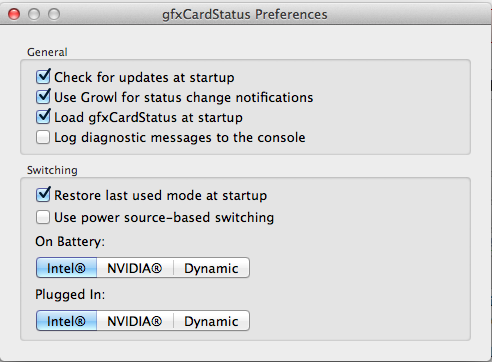

- #Gfxcardstatus external display install
- #Gfxcardstatus external display driver
- #Gfxcardstatus external display pro
For example, Google Chrome and Skype, among many others. gfxCardStatus provides a lot of control over which card is in use at any given time, and can also just notify you when the system decides that you should be using a different graphics card, and shows you why exactly the switch was made (under "dependencies"). It's a great utility.Some Windows notebooks, like Toshiba's Tecra W50, have both integrated and discrete (usually high-end) graphics technology. The higher-end graphics technology on a mobile workstation or gamer's system can itself consume upwards of 60 watts of power. If that's your setup, go conservative and use the lower-power integrated graphics whenever the workload doesn't demand all-out video power, such as for Web browsing or writing emails. If you've got discrete graphics from Nvidia or AMD, you should also have a utility that lets you manually or automatically make the change based on load. I'd also suggest that, when you're using the integrated graphics, use the most aggressive power management settings you're comfortable with. You can usually make power adjustments using either Intel's HD Graphics Control Panel or AMD's Start Now Technology screen, depending on which processor your computer is using.
#Gfxcardstatus external display pro
This goes for Macs as well: A 15-inch MacBook Pro with Retina Display can be ordered with Nvidia's GeForce GT 750M graphics accelerator with 2GB of video RAM. The system automatically switches between integrated and discrete graphics when you've checked the box in the upper left corner of its Energy Saver window.
#Gfxcardstatus external display install
If you want to manually go between graphics adapters on a MacBook Pro, you can install the free app gfxCardStatus, which tells you which of your applications are more power-hungry and lets you manually toggle between integrated and discrete graphics. Nearly every Windows-based notebook comes from the factory set to shut itself down when 7% of battery power remains. This buffer is meant to be an extra safety margin to provide enough power to shut the system down and not lose key data or documents.


I'm sorry.Several years ago, I started setting my notebooks to leave a 1% or 2% power reserve instead - as a result, I added more time to work, and I've never had a problem.īut in actual fact, it wastes 10 or 15 minutes of precious battery life.

Having said all of that, I wouldn't expect this to be fixed any time soon (or maybe ever), unless someone else decides to track this down and contribute a fix. I'd really like to avoid getting into the business of doing OS update-specific fixes to work around what seem to be semi-frequent changes to the muxing driver.
#Gfxcardstatus external display driver
Unless you're using Integrated Only mode for the purpose of keeping your machine alive until you can get it replaced or fixed, I'd really recommend against using it at all.Īdditionally, given that this didn't seem to occur on older versions of OS X, but now does, that would seem to indicate that something about the GPU muxing driver has changed, which could be difficult to work around. As OS X has evolved, and app developers have become more aware of the perils of developing for dual GPU MacBook Pros, using Integrated Only mode has become less and less necessary. For quite a while, I've been suggesting that gfxCardStatus be used exclusively in Dynamic Switching to obtain information about which apps, if any, are causing your discrete GPU to turn on unexpectedly.


 0 kommentar(er)
0 kommentar(er)
